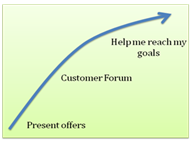Web 2.0 means a lot of things to people. It’s the rating of things by a community, it’s chat, and it’s collective learning. For a bank it can mean finding a relevant context to present offers to customers; moving from intrusive selling to customer goal realization. Web 2.0 also allows for collective learning and an increased sense of engagement that transforms passive customers to advocates.
There are several tools in the personal financial management (PFM) space. There are several tools in the personal financial management (PFM) space. They include Wesabe, Geezeo, Mint, mvelopes, yodlee Smarty Pig, and Quicken Online. Even large banks like Bank of America are offering money management tools to compliment their services. Each PFM has its own areas of focus and functionality. I met with Gabe Griego, VP of sales and marketing at Wesabe on Wednesday and had an interesting conversation about the use of Web 2.0 to increase the level of consumer engagement with money and their bank.
Wesabe is a great example of a company that understands the power of Web 2.0. It was built around the concept of community and that learning from many is powerful. Wesabe originated as an online community for managing personal finances. The latest offering from Wesabe for community banks, Springboard, has brought them further into the sphere of customer engagement and relationship transformation.
The concept of a group knowing more than the individual is a powerful component of Web 2.0. As payments professionals, the collective learning around bank account and card statement merchant codes is particularly compelling. How many times have you looked at your bank or card statement and wondered if MerchantXYZ123 was a real merchant, a typo, or worse, fraud on your account? In the community created by these PFM companies, this learning is extensive. The translation from code to real world merchant name benefits the merchants with fewer chargebacks and consumers with understanding of their transactions.
Many banks are facing the demographic reality of a young online customer base that is getting older and the segment is growing. When a customer is in a real world bank, they are relatively captive. Online, a consumer is only one click away from the next bank’s site or, worse, an independent site providing price and feature comparisons. Customer engagement is difficult and essential to reduce the commoditization of bank offerings.
If you think about traditional interaction with your online bank, you are faced with screen after screen of product offerings. Online banking channels are very good vehicles for presenting information, products and offers to customers. The offers lack any context however, and banks often perform extensive data mining exercises to strive to understand customer segmentation to generate targeted offerings. True Web 2.0-type offerings allow the bank to move to a segment of one. Understanding what the customer searches for and the products they already have, enables context based offers – much like Google Search creates contextualized ads or Yahoo Local can create geography-context for results.
As online banks look at Web 2.0 and engaging a community, some of them have begun offering customer forums for feedback. As Gabe suggests “The customer is talking about you whether you like it or not. Wouldn’t you like to know what they are saying?” Companies that understand Web 2.0 are not afraid of customer complaints. Customer engagement increases with affirmative responses to the postings and as other customers become strong advocates by explaining and helping other customers.
Here at Glenbrook Partners, we have been thinking about taking the customer engagement even further. We see a progression from a discussion forum to truly contextualized product offers that support the consumer in reaching their goals.
Several of the personal financial management tools focus on goal setting. The most powerful level of customer engagement is to help the customer reach a goal. The integration of goal setting and discussion forums into online banking can create levels of personal service only seen in private banking. Mint has taken a direct approach to creating offers for their community. Wesabe in contrast, is creating a platform on which banks can create the community and their own contextualized offers.
Offers that help the customer achieve a personal goal are much more compelling. For example: The customer sets a personal financial goal to reduce credit card balances ,or joins a forum for customers trying to achieve that goal. Offering this customer a low interest loan to pay off card balances and reduce monthly interest payments is an appropriate strategy. The bank may also encourage them to use a debit or prepaid card for certain expenses and switch to automatic deduction to reduce late fees.
This type of contextualized offer is truly based upon knowledge of the customer. While the bank may trade short-term gain on the card balance interest, the lifetime value of the customer that is looking for a solution is a powerful offset.
This level of customer engagement and knowledge was previously only available in traditional physical world private banker relationships to clients of certain balances. Online banking sites need to think about community and Web 2.0 as a way to engage customers and increase retention.
Additional Information:
- Personal Finance Tools Bring New Value to Online Channel, Banktech – Jan 5, 2009
- Glenbrook Partners Survey Results on the Web 2.0 Savvy of the Payments News community Glenbrook-survey-results


